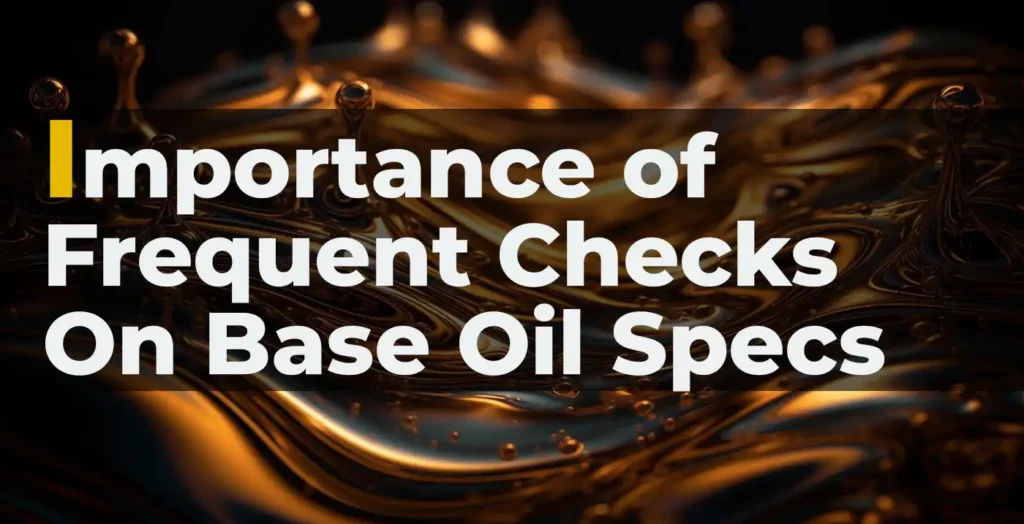
Whether it is your vehicle or the machinery, lubricants are crucial in keeping its wheels running smoothly. As the main factor of any lubricant, base oil controls the spectrum of your engine’s efficiency and longevity. Base oils form the majority of the lubricant’s composition. They act as a canvas for various additives mixed to form different kinds of lubricants. It can be synthetic, mineral, or a blend of both. Therefore, there are several factors you need to keep in mind when selecting a lubricant. Also, it is essential to do a periodic examination of the base oil specifications of your lubricant. In this blog, let’s explore the importance of regularly checking base oil specs and how they benefit the overall performance of lubricants.
Consistency Is The Key
One of the important aspects of checking on the base oil specs is to ensure consistency. When it comes to the performance of a blended lubricant, the primary responsibility always lies with the blender or marketer. Therefore, the blenders need to be concerned about whether the base oil they’ve purchased is fit for the intended purpose or not. For almost every blender, if they are purchasing the base oil from a supplier regularly, they expect it to be the same as the last time. Because consistency in base oil directly contributes to the consistency of lubricant. The changes in the base oil properties can lead to many adverse effects such as altered viscosity, thermal stability, and overall lubrication. This will later lead to the machine’s malfunctioning and early damage. Therefore, this trust between blenders and suppliers is critically essential for the blending process to be straightforward and ensure consistency in the blended lubricant’s performance and marketing claims. Also, this will help the blender from unnecessary alteration in formulations in the case of viscometrics and additives.
If you’re a blender or marketer and you’re buying the base oils from a third-party supplier it will always be best to check the samples of each grade of the supplier’s slate in detail. Because this frequent check will bring advantages at a later date. If your base oil has met the intended requirements, your regular lube customers will have the assurance of the performance of your lubricant. And thereby you’ll gain the customer’s ultimate trust. Moreover, if you have a good quality base oil, the blending laboratory will be satisfied with its performance and also provide satisfactory feedback to the purchasing managers about your product.
Specification Values and Typical Values
There are several things you need to consider when you set up a base oil supply agreement. For a base oil, its specification values are very significant. When it comes to the base oil supply contract, it mentions a set of specification values and typical values. Therefore, it is critical to ensure that the difference between specs and typical values is reasonable. Because there is a high chance of exploitation of the delta between specifications and typicals by the manufacturers. The large difference between specifications and typicals will lower the quality of the base oil.
For example, to increase the rate of production some manufacturers increase the delta between specifications and typical while formally being within the contractual specifications. If we consider the saturates levels in API Groups 2 and 3 the utilization is better in higher saturates. Mostly, the offered specification of a base oil is more than 90 percent by weight of saturates. now, consider a Group 2 base oil with more than 90 percent saturates and a Group 1 base stock with 88 percent saturates, within these two the Group 2 base oil will always be better in performance. But if we compare this base oil with another Group 2 with a typical saturate level of more than 95 percent, the former won’t even stand a chance.
Compatibility With Additives
Another point is the compatibility of base stocks with additives. To enhance the performance of lubricants, they contain various additives. Therefore, when it comes to the optimum efficiency of lubricants, base oils need to be compatible with additives. Keeping a close watch on base stock specifications will ensure that any changes in formulations or additives do not compromise the quality of blended lubricant.
Besides, the lower saturated base oil may have less compatibility with additives and antioxidants. This will adversely affect the lubricant’s performance, especially for lubricants such as hydraulic fluids or industrial turbine oils which have low treat rates.
However, in some cases, the typical value of a given specs parameter is not considered as long as the base oil is consistent. Because the blender will formulate the lubricant by compensating it with the additive package. And this additive treat rate will reflect the quality of the base oil being used. But it also has its limitations. Because some base oils have a greater quality shift that cannot be compensated with the additives. In point of fact, some parameters like air release cannot be compensated with additives at all. Therefore, a blender needs to assess the delta between specs and typical values of the base oil provided by the manufacturer in the blending laboratory before signing the supply agreement. If the specs don’t meet your requirements, it is better to walk away from the agreement. Since it will avoid a lot of problems like logistical issues in the future.
Clear Understanding of Specifications
In addition, you need to ensure that both laboratory personnel and product managers fully understand which specifications are necessary and which are not. In some cases, some specifications are inserted without a proper understanding of the performance or understanding of base oils. Due to this, there occur unnecessary specification checks that overshadow the relevant quality issues. Moreover, there are some cases of coupling of excess specifications. That means, one specification is effectively controlled by another in the list that makes it pointless. Therefore, base oil specifications and typical sheets for supply contracts have to be with independent variable specifications. The sheet’s author should be confirmed about what the very specification represents.
Viscosity And Temperature Stability
Viscosity and temperature stability are the two most important factors of a quality lubricant. The same goes for the base oil. The viscosity of the base oil will determine the ability of a lubricant to flow and form a protective barrier between moving parts. furthermore, a base oil must possess adequate thermal stability. This will help the lubricant to perform its function seamlessly in both low and high-temperature ranges. Consequently, frequent checks of base oil specs will help you to maintain desired viscosity ranges, and identify deviations in thermal stability allowing for timely adjustments.
Environmental Impact
As a manufacturer, it is essential to consider the environmental impacts. The concerns about the environment and debates on human involvement in environmental destruction are rising day by day. From small-scale entrepreneurs to multinational lubricant companies, everyone is supporting and promoting eco-friendly productions and business ideas. Hence, the environmental impact of base oils also has a particular significance. Some base oils such as synthetic ones have great eco-friendly characteristics. For that reason, routine checks on base oil specs will allow blenders to choose the one that aligns with sustainable goals
In conclusion, the routine checks on the base oil specification are the foundation of the entire lubrication process. By keeping an eye on base oil specs, blenders or manufacturers can avoid a lot of issues like having to exclude a given base stock slate from blending certain products, unnecessary disputes with suppliers, and hindered blending processes. So, next time you think about formulating blended lubricants, giving a little attention to base oil specs will lead you to a long successful way.


